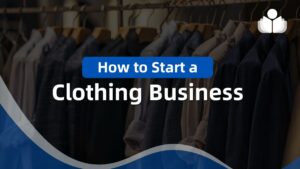As a new entrepreneur, you will likely find yourself short on two critical resources: time and money. Startups often don’t turn a profit immediately, and without sufficient funds to pay yourself or hire help, the pressure to make sales quickly is intense.
This is why many new businesses turn to dropshipping. This model allows you to outsource manufacturing, warehousing, and shipping to a third-party seller, enabling you to minimize overhead costs and concentrate on actionable tasks like marketing and enhancing the online shopping experience.
However, just because dropshipping is a more accessible business model doesn’t mean getting started is straightforward. Don’t worry, though!
Here’s a step-by-step guide on beginning dropshipping: identify your niche, define your target audience, find trustworthy suppliers, set up your e-commerce store, and market your business. Let’s dive into each step.
>> Launch Your Dropshipping Business Now! >>
What Is Dropshipping?
Dropshipping is a business model in which a company sells products without holding any inventory. Here’s how it works: a customer places an order, and the company notifies the manufacturer or distributor that an order has been placed.
The manufacturer or distributor then directly ships the product to the customer on behalf of the dropshipping company.
The process is straightforward: the consumer pays the drop shipper, who pays the manufacturer or distributor, and then the product is shipped directly to the consumer. Essentially, the drop shipper acts primarily as a marketer.
This model is particularly appealing for new entrepreneurs because it eliminates the need for inventory, reducing overhead costs significantly. Additionally, it avoids the risk of being left with unsold stock, making it a lower-risk option for starting a business.
>> Start Your Dropshipping Business Now! >>
Pros & Cons of Starting a Dropshipping Business
Pros of Starting a Dropshipping Business
- Low Startup Costs: One of the most significant benefits of dropshipping is the minimal initial investment required. You don’t need to spend heavily on inventory, warehousing, or logistical operations, making it a cost-effective entry point.
- Ease of Starting: Dropshipping simplifies the startup process by eliminating the need to handle physical products, which makes it more accessible compared to traditional retail models.
- Flexibility: Since dropshipping businesses primarily operate online, you can manage your business from anywhere with an internet connection. This flexibility enables you to run a home-based business effortlessly.
- Wide Product Selection: Without the need to pre-purchase items, you can offer a diverse range of products. Suppliers have the item in stock, so you can list it on your website without incurring additional costs.
- Scalability: Dropshipping is more scalable than traditional retail because you can expand your product range and increase order volumes without a corresponding hike in overhead costs.
>> Launch Your Dropshipping Business Now! >>
Cons of Starting a Dropshipping Business
- Low Margins: The low barrier to entry in dropshipping leads to high competition, which can significantly compress profit margins, particularly in markets flooded with generic products.
- Supplier Errors: Relying entirely on third-party suppliers for product fulfillment can introduce logistical challenges, such as incorrect shipments or items needing to be out of stock, with the responsibility for customer service falling on your shoulders.
- Shipping Complexities: Working with multiple suppliers can complicate shipping logistics. Suppliers may have varying shipping rates, and costs can increase if a customer orders multiple items that need to be shipped from different suppliers.
- Limited Customization and Branding: Since products are shipped directly from the supplier, you have minimal control over packaging and branding. This limitation makes it difficult to distinguish your offerings from those of your competitors.
- Customer Service Challenges: Managing customer complaints can be problematic because you need to oversee inventory or direct order fulfillment. Dependence on suppliers to address issues can lead to delays and increased customer dissatisfaction.
How to Start a Dropshipping Business: 6 Steps to a Profitable Dropshipping Business Plan
1. Choose a Business Concept
2. Source Products
3. Select Suppliers
4. Build an Online Store
6. Market Your Business
1. Choose a Business Concept
A business concept outlines what you’re selling and who your target customers are. With the variety available in dropshipping, it’s wise to begin with a select range of products tailored to a specific audience.
For instance, you might develop a concept of selling graphic T-shirts to skateboarders. These T-shirts would feature designs that resonate with the skateboarding community and match the quality and style that skateboarders prefer.
Your business concept lays the groundwork for everything from the products you offer to your website’s design and marketing strategies.
It’s important to invest time in refining this concept. However, it’s also beneficial to remember that the low overhead costs associated with dropshipping allow you to pivot or adjust your approach if you discover that your initial idea isn’t working or your interests evolve.
>> Open Your Online Store With Tailor Brands >>
2. Source Products
A well-defined business concept is a strong start, but it doesn’t ensure access to the right products for your target demographic. Before diving into website development, dedicate time to researching potential products. It’s wise to identify multiple distributors offering the same items to secure the best wholesale prices.
Here are some of the most popular marketplaces to explore for sourcing products:
- AliExpress
- SaleHoo
- Worldwide Brands
- Doba
- Megagoods
- Wholesale Central
You might consider exploring print-on-demand options for apparel, home goods, or books. Print-on-demand companies customize products like T-shirts, socks, and jackets with unique graphics on a variety of brands and styles.
When selecting a product, choose one that excites you, offers a good profit margin, and looks appealing in the images displayed on the supplier’s website.
Many suppliers also offer sales statistics for their items, allowing you to choose products that are more likely to sell based on existing market demand. This can be an effective strategy to ensure you’re investing in items with a proven track record.
3. Select Suppliers
Once you’ve selected the products you wish to offer, the next step is choosing the right supplier to ship these products to your customers. Here are several critical factors to consider when selecting a supplier:
- Quality: Opt for a supplier whose products align with the quality standards you want your brand to represent. Decide whether you want to position your business as a premium provider with higher-quality goods at a higher price point or as a budget-friendly option offering lower-quality products. This decision will significantly influence your brand image.
- Profitability: Ensure you can achieve a reasonable profit margin on the products after accounting for shipping and transaction costs. Most drop shippers aim for profit margins between 15% to 20%. Naturally, higher margins are preferable if achievable.
- Reliability: It’s crucial to choose a supplier known for timely and reliable product shipments at reasonable shipping costs and durations. Given that many suppliers are based overseas, consider the potential wait times for your customers. Additionally, ensure the supplier maintains consistent stock levels to avoid the frustration of unfulfillable orders. A good practice is to test the supplier’s reliability by ordering a few items yourself to experience their process firsthand.
- Return Policy: Ideally, work with a supplier that offers a return policy. This feature is not always available, so verifying this before finalizing your choice is important. Your own return policies should be aligned with what your supplier offers.
While many dropshippers utilize online marketplaces for a broader inventory and reliable suppliers, direct sourcing from a supplier is possible if you have a specific product in mind. This route may require additional efforts to identify who distributes the product for the manufacturer and might necessitate meeting minimum sales quotas monthly.
>> Open Your Online Store With Tailor Brands >>
4. Build an Online Store
Building an e-commerce store is essential for selling your products online. An e-commerce website not only displays your products attractively but also includes the necessary functionalities like shopping carts to facilitate purchase transactions.
Setting up an e-commerce store can be challenging, especially for beginners, due to the various components involved. Here’s what you’ll need to build your website:
- A content management system (CMS) like WordPress, Shopify, or Squarespace
- A registered domain name
- Web hosting services (required for WordPress sites)
- Integration capabilities with your selected dropshipping suppliers
- A secure payment gateway for processing online transactions
The most efficient e-commerce websites streamline operations by automating the connection between product sales and supplier orders. Without automation, you could find yourself manually processing orders daily, which is not only time-consuming but also prone to errors.
While Shopify is a top choice for many dropshipping businesses, it’s beneficial to explore other e-commerce platforms to find the one that best suits your needs.
In addition to your main e-commerce site, consider expanding your reach by selling on other platforms such as Etsy, Amazon or even through social media channels like Facebook or Instagram.
Engaging in multi-channel selling can significantly enhance your business’s visibility and increase sales. However, it’s important to ensure you have the capacity to effectively manage multiple sales channels before expanding.
>> Launch Your Dropshipping Business Now! >>
5. Register Your Business
To safeguard your personal assets and establish your venture as a separate entity, you need to set up your company formally. This process includes choosing a business name (often the same as your domain name) and registering as an LLC or corporation with your state’s Secretary of State.
After registration, you’ll obtain a Tax Identification Number (TIN) from the IRS through an online application. This TIN allows you to open a business bank account, which will be linked to your payment gateway. This account will handle all transactions, including receiving deposits, covering company expenses such as web hosting and maintenance, and paying suppliers for products ordered.
Additionally, you should acquire a sales tax ID or reseller’s permit from your state tax authority, as most states require the collection of sales tax on goods sold. Depending on where your customers are, you may also need to handle sales taxes in multiple states.
Utilizing an LLC registration service can simplify setting up your business entity, ensuring you understand all the terms and conditions and facilitating a smooth registration process. If you’re considering registering as an LLC, exploring the services offered by various companies could be beneficial.

Tailor Brands provides an online business registration service designed to simplify the process for entrepreneurs. The platform is user-friendly, offering a straightforward, step-by-step guide through the legal requirements and necessary documentation needed to establish a business as a separate legal entity.
With Tailor Brands, entrepreneurs can easily obtain a tax ID number, register for all necessary licenses and permits, and access a variety of resources to help ensure their business is properly set up for success. This service is ideal for those looking to efficiently navigate the complexities of business formation.
ZenBusiness is highly regarded for its rapid business filing capabilities and affordable incorporation fees. Their customer service team is readily available throughout the process to assist with inquiries, though they do not provide legal advice.
Starting a business may seem simple compared to the ongoing management required. ZenBusiness offers a variety of tools to simplify these tasks. The company can assist with tax documentation or act as a registered agent, reducing the administrative burden on you. This support can be invaluable for both new and seasoned business owners looking to streamline operations.

Northwest Registered Agent is renowned for its transparent approach to business registration and its commitment to treating customers with genuine respect. The company prides itself on clear pricing and exceptional, accessible customer service, ensuring tasks are completed correctly from the start.
Additionally, a significant focus is placed on the security of private information, emphasizing the importance of confidentiality and trust in their services.
6. Market Your Business
Setting up a website is just the beginning; you also need to market your new business to attract visitors and customers actively. Since your business is online, traditional word-of-mouth marketing in your local community might not suffice.
Start by joining and actively participating in social media groups related to your business niche. Don’t just promote your products; engage constructively by answering questions and offering advice.
This helps establish you as an expert and a go-to resource, indirectly leading people to your business. Create specific business pages on platforms like Facebook, Instagram, and TikTok, and keep them active by regularly posting updates about new products, promotions, or industry tips and tricks.
In addition to social media engagement, consider investing in digital advertising. For example, you can set up targeted Facebook Ads with modest budgets, starting at $10 per day, to drive traffic to your e-commerce site.
Another effective strategy is to start a blog that incorporates search engine optimization (SEO) tactics to improve your site’s visibility on search engines. Combining these marketing strategies can significantly increase your store’s visibility and help convert visitors into customers.
>> Start Your Dropshipping Business Now! >>
How Does the Dropshipping Business Model Work?
Dropshipping is a fulfillment method that allows store owners to sell products directly to consumers without holding any inventory. When a customer purchases from a dropshipping store, the order is fulfilled and shipped directly to them by a third-party supplier.
In this model, the customer pays the retail price you set, you pay the supplier’s wholesale price, and the difference between the two prices is your profit. This system eliminates the need for you to handle physical products or invest in inventory.
To begin selling products, you need to establish an account with a supplier. Here are three common methods to find a supplier for your dropshipping store:
- By accessing a supplier database such as Alibaba or AliExpress
- Utilizing an integrated supplier directory like DSers within your store’s backend
- Employing a print-on-demand service such as Printify
For Shopify store owners, DSers offers one of the simplest dropshipping solutions. This tool allows you to source millions of products from the DSers marketplace via AliExpress and import them directly into your store with just a single click.
In the dropshipping business model, the onus is on you to create and manage your website and brand, as well as to select and market the products you wish to sell. Additionally, your business is responsible for covering shipping costs and setting prices that yield a healthy profit margin.
Test Products To Gauge Interest In Them
One of the major advantages of dropshipping is the ability to test new products to gauge market interest. This process is straightforward and primarily requires just the time to update your store and promote the new product.
Coordinate with your suppliers to identify upcoming products that may appeal to your target demographic. Start by introducing one product at a time. If you believe in the product’s potential, allocate a specific marketing budget. Launch targeted ad campaigns to see how this new product performs in comparison to your existing offerings.
Dropshippers should consistently test new products. Doing so can help them sell more to existing customers who already trust and buy from their brand. This strategy is easy and cost-effective, and it should be a continuous part of their business development efforts.
>> Open Your Dropshipping Business With Tailor Brands >>
Is Dropshipping Really Profitable?
Yes, dropshipping can be a profitable business model for merchants because it eliminates the responsibility for shipping and manufacturing. It’s a low-risk approach that avoids the substantial overhead costs typically associated with wholesalers, and with the right suppliers, it can yield attractive profit margins.
Business Tip: If you need more clarification about determining a product’s profitability, you can use tools like Shopify’s free profit margin calculator to help you calculate it.
Many dropshippers earn up to $100,000 per year as a side business. Therefore, if your goal is to reach a six-figure income from dropshipping, selecting reliable suppliers and focusing on building a strong brand is crucial.
However, starting a dropshipping business is highly competitive. Since it can be cost-free, you may encounter many competitors selling similar products at comparable prices. This competition underscores the importance of differentiating your offerings and enhancing your brand’s value to stand out.
How to start dropshipping – FAQs
Bottom Line – How to Start a Dropshipping Business
Anyone can start a dropshipping business by leveraging marketplace suppliers and template-based websites.
This business model requires minimal overhead to get started, allowing you to quickly transform a side hustle into a primary source of income with the right products that resonate with a specific demographic. You can become a business owner with as little as $100 and scale up there.
 Sections of this topic
Sections of this topic
















